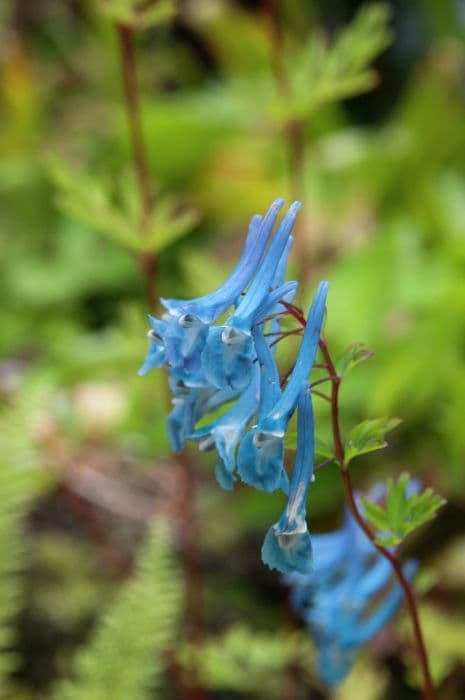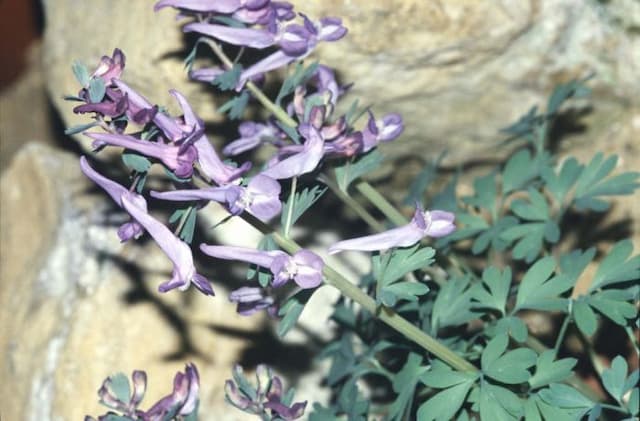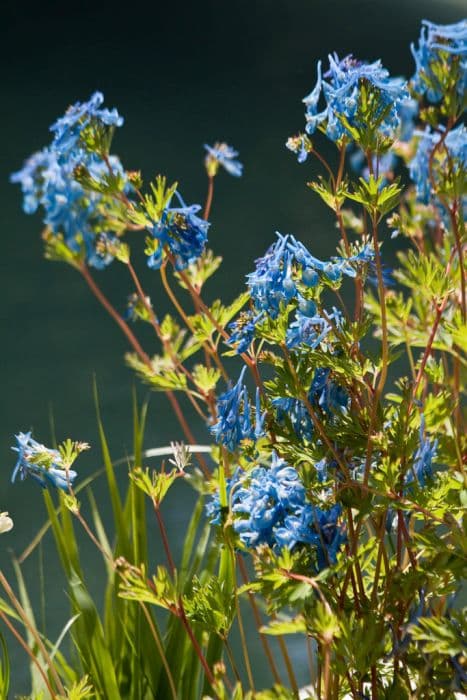White bleeding heart Lamprocapnos spectabilis 'Alba'

ABOUT
'Alba' is a perennial with divided, light green foliage and arching sprays of pure white, heart-shaped flowers
About this plant
 Names
NamesFamily
Papaveraceae
Synonyms
White Bleeding Heart, White Dutchman's Breeches, Alba Bleeding Heart
Common names
Dicentra spectabilis 'Alba', Diclytra spectabilis 'Alba'
 Characteristics
CharacteristicsLife cycle
Perennials
Foliage type
Deciduous
Color of leaves
Green
Flower color
White
Height
2 feet (0.6 meters)
Spread
2 feet (0.6 meters)
Plant type
Herb
Hardiness zones
5
Native area
Asia
Benefits
 General Benefits
General Benefits- Ornamental Value: The Lamprocapnos spectabilis 'Alba', commonly known as White Bleeding Heart, is highly valued for its distinctive heart-shaped white flowers that add aesthetic appeal to gardens and landscapes.
- Shade Tolerant: This plant thrives in shaded or semi-shaded areas, making it suitable for planting under trees or in parts of the garden that receive limited sunlight.
- Pollinator Attraction: White Bleeding Heart attracts bees and butterflies, aiding in the pollination of nearby plants and contributing to the health of the local ecosystem.
- Seasonal Interest: It provides visual interest in the spring and early summer when it blooms, bringing a seasonal highlight to gardens.
- Easy to Grow: This perennial is known for being easy to care for, requiring minimal maintenance once established, making it a good choice for both novice and experienced gardeners.
- Drought Tolerance: Once established, White Bleeding Heart can be quite resilient to periods of drought, reducing the need for frequent watering.
- Cold Hardy: It is capable of withstanding cold temperatures, making it appropriate for planting in a variety of climates, including regions with cold winters.
- Deer Resistant: The plant is not a preferred choice for deer, making it less likely to be damaged by wildlife in areas where deer are prevalent.
- Heritage Plant: With a long history of cultivation, the White Bleeding Heart is often appreciated for its classic and traditional appearance in garden design.
- Companion Planting: It pairs well with other shade-loving plants, such as hostas and ferns, allowing gardeners to create harmonious shade garden compositions.
 Medical Properties
Medical PropertiesThis plant is not used for medical purposes.
 Air-purifying Qualities
Air-purifying QualitiesThis plant is not specifically known for air purifying qualities.
 Other Uses
Other Uses- Lamprocapnos spectabilis 'Alba', commonly known as white bleeding heart, can be used as a natural dye; the pigments in the petals impart a soft color to fabrics.
- The plant's distinctive heart-shaped flowers can serve as a teaching tool in botanical illustration classes, where students learn to draw complex plant shapes and structures.
- Due to their intriguing shape and color, white bleeding hearts are often dried and used in crafting, for creating natural, romantic, and vintage-style jewelry like earrings or pendants.
- In landscape design, white bleeding hearts are used to create 'moon gardens', where all flowers are white, and are particularly visible in the twilight, thus enhancing the night-time garden aesthetic.
- Their robust stems can be used in flower arranging classes as a way to provide students with practice on how to support delicate flowers in complex arrangements.
- Traditionally, the white bleeding heart has been a symbol of purity and can be used in ceremonial plantings for weddings or memorial gardens.
- As a source of nectar, white bleeding hearts are planted to attract and support pollinating insects, including bees and butterflies, contributing to the ecological health of gardens.
- In creative cooking, the blooms may sometimes be used as a delicate garnish for desserts and salads, although they are not widely recognized for culinary use.
- During Easter, white bleeding hearts can be used in floral displays within churches or as part of celebratory arrangements, symbolizing compassion and the holiday's spiritual themes.
- Photographers and artists may utilize the white bleeding heart as a subject in workshops focusing on macro photography and botanical art, exploring its unique form and texture.
Interesting Facts
 Feng Shui
Feng ShuiThe plant Bleeding Heart is not used in Feng Shui practice.
 Zodiac Sign Compitability
Zodiac Sign CompitabilityThe plant Bleeding Heart is not used in astrology practice.
 Plant Symbolism
Plant Symbolism- Affection: The common name of Lamprocapnos spectabilis 'Alba' is Bleeding Heart, which symbolizes deep love and affection, reflecting the heart-shaped flowers of the plant.
- Compassion: Bleeding Hearts are associated with an open expression of compassion and empathy, providing a visual representation of heartfelt feelings.
- Rejecting love: Historically, the Bleeding Heart flower represents being spurned in love or the pain associated with love, often due to the appearance of the blooms resembling a heart with a drop beneath it.
- Elegance: The arching stems and graceful flowers of the Bleeding Heart convey a sense of refined elegance in the garden setting.
- Purity: The 'Alba' variety, with its white flowers, specifically represents purity and innocence, contrasting with the more common pink varieties.
 Water
WaterBleeding heart 'Alba' prefers consistently moist soil, so watering should be done regularly. In general, water when the top inch of soil feels dry to the touch, which typically means watering once or twice a week depending on weather conditions. During the growing season, watering might equate to approximately one inch of water per week, which is roughly 0.6 gallons for a standard size plant. Adjust frequency to accommodate rainfall, reduced watering when the plant is dormant in late fall to winter. It's best to water deeply and less frequently to encourage root growth rather than light sprinklings, which can lead to shallow root development.
 Light
LightBleeding heart 'Alba' thrives in partial shade to full shade. It is ideal to position the plant where it can receive dappled sunlight or light shade, especially sheltering it from the intense afternoon sun. A spot under a canopy of deciduous trees or on the north side of a building where it can avoid the harsh midday sun would be perfect for promoting healthy growth.
 Temperature
TemperatureBleeding heart 'Alba' prefers cool temperatures and is hardy in USDA zones, meaning it can survive winter temperatures down to -30 degrees Fahrenheit. The ideal growing temperature for bleeding heart 'Alba' is between 55 to 75 degrees Fahrenheit. It may struggle in temperatures above 80 degrees Fahrenheit, where it often goes dormant until cooler weather returns.
 Pruning
PruningBleeding heart 'Alba' should be pruned to remove spent flowers and to promote bushier growth. Prune dead or yellowing foliage throughout the growing season for aesthetic purposes. After the first frost in the fall, the foliage can be cut back to the ground. Pruning is typically done yearly and the best time for major pruning is in late winter or early spring before new growth begins.
 Cleaning
CleaningAs needed
 Soil
SoilBleeding Heart prefers a rich, moist, well-drained soil with a pH of 6.0-7.5. For the best soil mix, combine two parts garden soil, one part peat moss or compost, and one part perlite or coarse sand to ensure proper drainage and fertility.
 Repotting
RepottingBleeding Hearts generally do not need frequent repotting and can thrive in the same location for several years. It is best to repot these plants every 3-4 years to refresh the soil and address any overcrowding of the roots.
 Humidity & Misting
Humidity & MistingBleeding Heart thrives in average to high humidity levels. They can adapt to normal outdoor humidity but appreciate a slightly more humid microclimate if possible.
 Suitable locations
Suitable locationsIndoor
Provide bright, indirect light and keep soil moist.
Outdoor
Plant in part-shade, rich soil, and water regularly.
Hardiness zone
3-9 USDA
 Life cycle
Life cycleBleeding heart 'Alba' begins its life cycle as a seed, which, upon germinating in the spring, sprouts and develops into a young plant with characteristic heart-shaped foliage. It enters a rapid vegetative growth phase, during which the leaves and stems mature, and the plant prepares to flower. The flowering stage occurs in late spring to early summer when it produces distinctive white, heart-shaped flowers that dangle in a row from arching stems. After pollination, typically by bees, the flowers develop into slender pods that contain the seeds. Once the flowering is complete, the plant enters a period of senescence in summer where the foliage yellows and the plant may go dormant, retreating into the ground until the next spring. In subsequent years, Bleeding heart 'Alba' follows this seasonal growth cycle, rejuvenating in spring and going dormant in the warmer months after the reproductive phase is complete.
 Propogation
PropogationPropogation time
Late winter-early spring
The bleeding heart (Lamprocapnos spectabilis 'Alba') is best propagated by division, which is most commonly done in late fall or early spring. To propagate by division, carefully dig up the clump once the foliage has died back or before new growth begins. Gently separate the roots into several pieces, ensuring that each section has at least one eye, or growth bud. Replant the divisions immediately at the same soil level they were originally growing, spacing them about 12 to 24 inches (approximately 30 to 61 centimeters) apart to allow enough space for mature growth. Water the new divisions thoroughly after planting to help establish them. This method allows the plant to recover and establish itself during the cooler months, giving it a good start for the next growing season.









